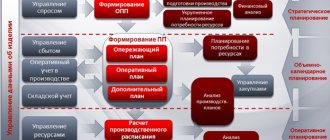What is a text outline and why is it needed?
An article outline is a list consisting of the main ideas of the article, which are presented in a logical sequence. The main task is to reveal the content. The ideal structure is one that, when you look at it, brings to mind the entire text.
Each item on the list is a guideline that helps you understand the essence of the article.
Why does a copywriter need to draw up and think through a plan:
- get rid of the mess in your head, sort all the information into shelves;
- make the material useful and exciting for the reader;
- thanks to a well-thought-out structure, the reader can easily find the block of information he needs;
- the number of clients and rave reviews will increase along with your income.
The ability to structure helps you prepare for exams and analyze competitors’ articles.
Drawing up an operational plan
The operational work plan allows you to ensure the implementation of the strategic goals of the enterprise. Unlike long-term plans, this type regulates the current activities of the company. Such a document may cover a period of up to three months.
The contents of the operational plan can be described as follows:
- the organizational structure of the enterprise, which must undergo changes or remain in the same state;
- manipulations with the existing technological base or the acquisition of new equipment;
- increasing the efficiency of economic efficiency in general or its individual indicators;
- determining the profitability of the coordinates of the enterprise itself or its main counterparties;
- improvement of inventory management procedures in order to ensure their savings;
- improvement of product quality control processes at all stages of its production;
- increasing the company's reputation among suppliers and clients by improving its image.
Making the structure correctly: detailed instructions
When you first sit down to write a plan, chaos usually begins in your head, and it’s difficult to identify the main idea. As a result, points that should be short are blown out into entire paragraphs.
For reference. The main idea is the task of the article/work, and the topic is the general name of the content.
Where to start and how to finish:
- Read the text 2 – 3 times. Take notes and write down ideas as you read. If you're writing from your head and don't need to study competitive articles, then skip this step.
- Ask yourself two questions: what is its topic, what is the material written for. This way you can immediately decide on the main idea.
- Take a closer look at each paragraph and think about where the key point is, what is its meaning? Often a paragraph is an already completed thought that can be included in the structure as a subheading. Don't dwell on the details. We are only interested in the action, the plot twist.
- Leave the list for a few minutes and relax. Re-read it. Do you understand what the work is about just by looking at it? Yes - you have worked well, no - you need to improve it.
- Copy the plan into a clean copy and use it for its intended purpose.
A few tips for the journey:
- Write down unfamiliar words and concepts that you will use separately. Be sure to clarify their meaning.
- Don't repeat yourself. If the same word comes up several times, replace it with a synonym.
- Don't be afraid of modifications. If, when you return to the list after a few minutes, you want to make changes, then do so.
- The text outline for a public speech should be short. One paragraph consists of a maximum of 2 – 3 words.
- Formulate paragraphs with numbers and subparagraphs with bulleted lists.
Keep a separate notebook for plans. Write down all your work there. This is a good source of inspiration that will help you keep track of your progress as you re-read it.
We took a look at the general way of structuring the article. Now let’s complicate the task and divide the plan into several types, each of which is created in a special way.
How to make a work plan for the year
Now the fun part - you have a list of goals, a list of steps and you have set your priorities. Now you need to plan things evenly for the year ahead.
A very common mistake in planning is to set a goal for the year at once. After all, it seems like there is so much time ahead, so you can put it off a little and do it later. And you can put it off indefinitely.
But now you need to do things differently and use the technique from the book “12 weeks a year”, and divide the to-do list into 4 parts - by quarter.
- January March,
- April June,
- July – September,
- October December.
The principle of such planning is simple - you simply do not have time to put things off until later. The deadline is always somewhere nearby.
The main thing here is not to overdo it and not to write down several large cases for one quarter. Remember - these things need to be done in parallel with your daily duties, do not overestimate your strength.
What types of plans are there?
A plan helps us not to get confused, to clearly formulate and express our thoughts. There are many options. Now we will look at the most well-known methods.
Abstract
Each section is represented by a thesis. Thesis is a brief statement of the main idea of 1 – 3 paragraphs. Distinctive feature: many verbs. It consists of a subject, which names the topic, and a predicate, which reveals it. Without a predicate, the main idea is lost.
How to find a thesis statement? It is difficult for beginners to highlight the main thing, discarding the details. Sometimes the subtitle of the structure is stretched to 10–15 words, although this is unacceptable. Ask questions about the paragraphs. But remember: the answer should consist of 4 – 8 words and no more.
For example, I took the fairy tale about the goldfish by A. S. Pushkin:
- The older man lived poorly with his old lady.
- The old man caught the magic fish and released it.
- Starce told everything to the old woman, she demanded a trough.
- The dissatisfied old woman sent the old man to fetch the hut.
- The hut was not enough for the grumpy old woman; she wanted to become a queen.
- The old woman was tired of being a queen, she wanted to become the mistress of the sea.
- The fish could not bear the old woman's greed and disappeared.
- The old man and his wife were left with nothing.
Every 1,000 characters = 1 abstract. If you are writing a 6,000 character article, you need to highlight 6 points. This way you won’t overdo it with water in the text, the material will be pleasant to read.
Interrogative
This type of structure is based on questions to a semantic block of text. Personally, it’s easier for me to work through an article this way. Questions arise while studying materials and thinking about the topic.
This plan is ideal for informational articles, master classes, instructions, and analysis.
I will again show what it looks like using the example of a fairy tale about a goldfish:
- What did the old man do when he caught the magic fish for the first time?
- How did the old woman react to the story about the goldfish?
- What did the old woman make her husband ask the fish?
- How did the fish respond to the old woman's last wish?
- What happened to the old man and his wife at the end?
Ask questions using words: how, when, why, whose, how many, who. Avoid the interrogative “whether” part.
Nominative
The title plan consists of theses expressed by nouns and adjectives. No verbs needed. It's very short. The maximum size of one title is 2 – 4 words.
Let's return to our tale of the goldfish to see the naming plan in practice:
- Meeting of an old man and a goldfish.
- The whims of an old woman.
- An old man and an old woman at a broken trough.
Remember the childhood classics? So everything is correct. If just one glance at the outline is enough to remember the contents of the article, you are on the right track.
Support
The reference plan is written without rules. This is a short retelling of the article, consisting of the main informative parts. It is intended for personal use. It is important that you feel comfortable and understandable when working with it. All points are supports that evoke vivid, detailed pictures that convey the content of the article.
You can write it expanded or condensed. It all depends on your goal, capabilities, memory, associations.
This is how I see the correctly written supporting plan of the famous fairy tale:
- The first meeting of the old man and the goldfish.
- Three wishes of an old woman.
- Fish refusal.
- Broken trough.
The supporting structure is provided for public speaking, presentations, news articles, and brief reviews. So as not to miss the main idea, but also not to constantly look at the sheet of paper. Indicate facts, figures, names of objects, characters.
Mixed
This is a mix of different types of plans. Ask questions, write out abstracts - no restrictions.
For clarity, I will show the combined structure of a fairy tale about a goldfish:
- The elder came across a magic fish, which he felt sorry for. He let her go.
- How did the old woman behave when she heard about the unusual fish?
- Three wishes of an old woman.
- Why did the goldfish refuse to fulfill his last wish?
- The old man and his wife returned to their old lives.
You can use it for any purpose.
Simple and complex
What kind of plan do you need: detailed or simple. To make the right choice, think about how important it is to describe the details or can you get by with nominal sentences?
A simple structure is 3 – 5 headings without details, consisting of 2 – 5 words, and a complex structure is more than 5 headings with subheadings and important details.
For example, the fairy tale “Kolobok” can be represented as follows:
| Simple structure | Complex structure |
|
|
Practice writing a simple plan. As soon as you start to succeed, try making an expanded one.
As you can see, the simplified version indicates only the key points, the complex one helps to understand the behavior of the characters and the development of the storyline.
Procedure for drawing up plans
Drawing up business plans for enterprises involves going through several successive stages:
- identification of possible problems and risks that the enterprise may encounter in the future;
- determination of the goals of the enterprise, as well as their clear economic justification and assessment of the reality of their implementation;
- planning the material, technical and financial condition of the enterprise; estimating the cost of resources that are necessary to achieve the objectives;
- detailing goals by dividing them into separate specific tasks;
- development of measures to monitor the implementation of plans, as well as determining their schedule.
Without drawing up clear and detailed plans, it is impossible to ensure the smooth and efficient functioning of the enterprise. Management must have a clear understanding of the goals of the activity, as well as the means that will be needed to achieve them. In addition, all types of plans enable the company to mitigate the impact of economic fluctuations.
Typical mistakes + examples
During the learning process, beginners often make the same mistakes. Self-study is dangerous because the author does not always notice his weak points in time, gets used to them, and begins to write subsequent plans in the same style. A mentor is needed at this stage. Where can I find it? You don’t have to go far, surf the Internet, we have been teaching copywriting for a long time and are ready to help you.
In the meantime, I will introduce you to common mistakes that make the plan unworkable:
- There is a violation of the logical connection, each point lives a separate life.
- Points intersect with each other, semantic boundaries are violated. The author was unable to divide the text into key points or described the content in too much detail.
- All points indicate secondary information. Most likely, the author was unable to determine the idea or topic of the article.
- The introduction and conclusion are missing.
- The author chose the wrong words to name the points. It is impossible to understand what is going on.
- The length of the paragraph exceeds 9 words, resembling a paragraph.
- The size of the items, the appearance are too different. This is only permissible when writing a combined plan.
Write down a list of errors and hang it on your desk. Every time you sit down to prepare a plan or review it, go through the list.
Have you written a plan? Don't rush to use it. Let it sit for at least a few hours, and then evaluate it with fresh eyes.
Let's imagine what the wrong outline for the article “How to teach a child to speak?” would look like.
- When does a child learn to speak?
- The child does not speak.
- What should you tell your baby?
- How to teach a child to speak quickly and clearly?
- Frequent mistakes that parents make: they read little to their child, force them to study, scold them.
Even a simple look at such a structure causes chaos in the head: what, why, what are they even about.
What mistakes are made here:
- Point 1 is superfluous. We are talking about how to teach a baby to talk, not when. It’s better to write a separate text about this.
- Point 2 is thesis, and we frame everything with questions. It looks clumsy and illogical.
- Point 3 can be made a sub-point for ease of perception.
- Point 5 is long, homogeneous terms after the decimal point should be formulated as subparagraphs.
And here is the corrected version:
- Introduction.
- How to teach a child to speak quickly and clearly: reading aloud,
- developing tongue twisters,
- articulation gymnastics,
- a lot of communication,
- word games.
- annoying training
Learn to write similar texts for the article exchange to earn money.
A few words about setting deadlines
One of the most difficult aspects of creating a work plan is establishing deadlines that can realistically be met. A work schedule always looks better on paper than in real life. There are always obstacles, delays, and even disasters (and, of course, excuses) that can turn the best plan ever made into useless waste paper destined for the trash can. The situation will only become more complicated when time is already limited (as is the case during elections). Election day is a clearly defined, absolute deadline. When you were in school, the dog could actually eat your homework notebook. As for the elections, here you will no longer have the opportunity to do your homework again.
- Therefore, it is always worth leaving a small margin of time in your plan for completing activities. Leave a small gap between the deadlines for completing individual items of the plan so that if one event fails due to unforeseen circumstances, it does not automatically entail failure to meet all other deadlines. Leave yourself some time so that you have the opportunity to get back on schedule if you don’t have time to do something during the execution of what you planned.
Another challenge faced when setting deadlines is maintaining logical consistency. When drawing up a work plan for an educational program, the question sometimes arises: “What comes first: the chicken or the egg?” For example, what needs to be developed first: a methodological manual for members of a precinct election commission or a training manual for instructors-methodologists? Be careful! The answer to this question is not as simple as it might seem.
All this is also difficult because you are faced with a huge number of actions and activities that need to be tied together. I can assure you that you will have to adjust the time of methodological training to the timing of the production of printed materials that you are going to use in these classes. It is quite possible that in the subject of the Russian Federation where you work there are problems with transport and communications. Surely, the various topics of the methodological classes you conduct must be agreed upon and approved by various people. It may also happen that your assistants will be scattered in different places. You need to think through all this carefully.
- Make sure that everyone involved in a given project can come together for a strategic meeting so that the right hand always knows what the left hand is doing.
Once you've outlined your work plans, it's also a good idea to create a calendar chart that shows all the deadlines set for completing the various tasks. List these tasks in time order rather than in order of task importance. When you reflect each scheduled deadline on a separate sheet, you will be able to see in which places the sequence is broken, where deadlines overlap, and where they turn out to be unrealistic to fulfill. After this, you can return to your work plans and make changes where necessary.










